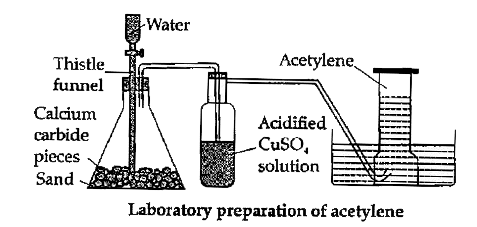When iron rod is immersed in copper sulphate solution.
Step-by-Step Solution:
1. Identify the Reactants:
When an iron rod (Fe) is immersed in a copper sulfate solution (CuSO₄), we start with two main reactants: solid iron (Fe) and aqueous copper sulfate (CuSO₄).
2. Reactivity Series:
In the reactivity series of metals, iron (Fe) is more reactive than copper (Cu). This means that iron can displace copper from its compound.
3. Displacement Reaction:
Since iron is more reactive, it displaces copper from copper sulfate. This is a type of single displacement reaction.
4. Color Change Observation:
The color of the copper sulfate solution is blue. When iron is added, the solution changes color from blue to pale green. This indicates that copper ions are being displaced and solid copper is forming.
5. Write the Chemical Equation:
The chemical reaction can be represented as:
CuSO4(aq)+Fe(s)→FeSO4(aq)+Cu(s)
Here, copper sulfate reacts with iron to form iron sulfate and solid copper.
6. Identify Oxidation and Reduction:
In this reaction:
- Iron (Fe) is oxidized as it loses electrons to form Fe²⁺ ions.
- Copper (Cu²⁺) ions are reduced as they gain electrons to form solid copper.
7. Classify the Reaction:
This reaction is classified as both a double displacement reaction and a redox reaction because oxidation and reduction occur simultaneously.
When an iron rod (Fe) is immersed in a copper sulfate solution (CuSO₄), we start with two main reactants: solid iron (Fe) and aqueous copper sulfate (CuSO₄).
In the reactivity series of metals, iron (Fe) is more reactive than copper (Cu). This means that iron can displace copper from its compound.
Since iron is more reactive, it displaces copper from copper sulfate. This is a type of single displacement reaction.
The color of the copper sulfate solution is blue. When iron is added, the solution changes color from blue to pale green. This indicates that copper ions are being displaced and solid copper is forming.
The chemical reaction can be represented as:
CuSO4(aq)+Fe(s)→FeSO4(aq)+Cu(s)
Here, copper sulfate reacts with iron to form iron sulfate and solid copper.
In this reaction:
- Iron (Fe) is oxidized as it loses electrons to form Fe²⁺ ions.
- Copper (Cu²⁺) ions are reduced as they gain electrons to form solid copper.
This reaction is classified as both a double displacement reaction and a redox reaction because oxidation and reduction occur simultaneously.
Topper's Solved these Questions
- METALLURGYBook:ICSEChapter:METALLURGYExercise:WORK SHEET-2 ( Give two examples for the following: )
Explore 5 Videos
- METALLURGYBook:ICSEChapter:METALLURGYExercise:WORK SHEET-2 ( FILL IN THE BLANKS)
Explore 5 Videos
- METALLURGYBook:ICSEChapter:METALLURGYExercise:WORK SHEET-1
Explore 10 Videos
- ELECTROLYSISBook:ICSEChapter:ELECTROLYSISExercise:Assertion and Reason Based Questions
Explore 4 Videos
- MODEL PAPER -1Book:ICSEChapter:MODEL PAPER -1Exercise:SECTION -II
Explore 48 Videos
Similar Questions
Knowledge Check
When zinc granule is dipped into copper sulphate solution, copper is precipitated because :
ABoth, copper and zinc have a positive reduction potential.BReduction potential of copper is higher than that of zinc.CReduction potential of zinc is higher than that of copper.DBoth, zinc and copper have a negative reduction potential.

Give the function of acidified copper sulphate solution.
View SolutionWhen zinc rod is immersed in sulphuric acid.
View SolutionWrite your observations when ammonia water is added to copper sulphate solution first a little then in excess. Give balanced equations.
View SolutionWhat do you observe when
HS gas is passed through copper sulphate solution.
View SolutionWhat do you observe when ?
Ammonium hydroxide solution is slowly added to copper sulphate solution
View SolutionWhat do you observe when :
Ammonium hydroxide is added to copper sulphate solution first a little, then in excess.
View SolutionState one observation: A zinc granule is added to copper sulphate solution.
View Solution
